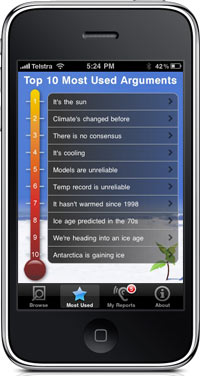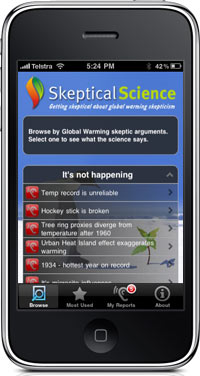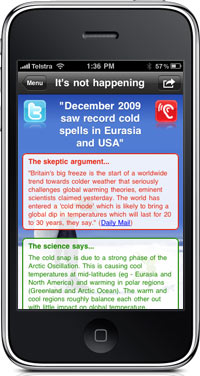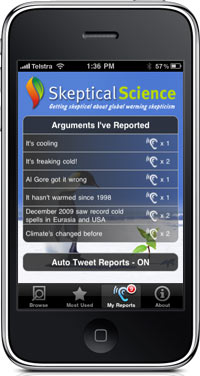Skeptical Science now an iPhone app
Posted on 10 February 2010 by John Cook
 With Tim Lambert debating Christopher Monckton this Friday, there's been no shortage of debating suggestions. One interesting idea was for audience members to have skepticalscience.com on their mobiles. Coincidentally, Skeptical Science has just become available today as an iPhone or iPod app. The app lets you use an iPhone or iPod to view the entire list of skeptic arguments as well as (more importantly) what the science says on each argument. To download the app, go to http://itunes.com/apps/skepticalscience
With Tim Lambert debating Christopher Monckton this Friday, there's been no shortage of debating suggestions. One interesting idea was for audience members to have skepticalscience.com on their mobiles. Coincidentally, Skeptical Science has just become available today as an iPhone or iPod app. The app lets you use an iPhone or iPod to view the entire list of skeptic arguments as well as (more importantly) what the science says on each argument. To download the app, go to http://itunes.com/apps/skepticalscience
How it happened was a few months ago, I was contacted by Shine Technologies, a software development company from Melbourne, Australia. The owners of the company are passionate about climate change and were interested in getting the science from Skeptical Science onto mobile phones. This is a good idea for two reasons. Firstly, because now more than ever it's imperative that the climate debate focuses on science so the more readily available the science, the better. Secondly, well, an iPhone app is pretty cool.
So for the last few months, the boffins at Shine have been developing the app with Apple approving it today. How does it work? You browse arguments via the Top 10 most used arguments as well as 3 main categories ("It's not happening", "It's not us", "It's not bad"):


When you select one of the 3 main categories, a list of sub-categories pop up. You can then select any category to see the skeptic argument, a summary of what the science says and the full answer including graphs plus links to papers or other sources.


A novel inclusion is a feature that lets you report when you encounter a skeptic argument. By clicking on the red ear icon (above left, shown to the left of the skeptic arguments or above right, next to the headline), the iPhone adds another hit to that particular skeptic argument. At the moment, which arguments you report are only available in a My Reports page, shown below. Shine Tech are hoping to play around with the Reports meta-data in future versions of the app - the phrase "heat-map" gets mentioned often.

So if you have an iPhone or iPod, be sure to download the app and post any feedback or suggestions here. If you have friends with iPhones, be sure to let them know of the app. The more people use the app, hopefully the more versions will be developed in the future with snazzy extra features. If anyone encounters any technical problems with the app, please let me know.
UPDATE 11 Feb 2010: Thanks for the feedback so far (I've passed it onto Shine Tech who I'm sure will be reading this thread also). One other thing I forgot to ask - for those who are able to use the app, please be sure to post a review on iTunes :-)
About Shine Technologies
Shine Technologies is the developer responsible for the Skeptical Science iPhone application. They are a boutique IT consultancy based in Melbourne, Australia with a passion for excellence. They have donated their time to build and maintain the Skeptical Science iPhone application as they believe the science is the key to understanding global warming; and that more people need to have easy access to that science.































 Arguments
Arguments






























The big downward spikes in net forcing are due to volcanic eruptions. Why doesn't temperature fall the same amount? Because of the great thermal inertia of the oceans. What happens is a volcano erupts, throwing up sulfate aerosols into the atmosphere. This immediately creates an energy imbalance - suddenly less sunlight is getting in. So the planet starts to cool.
Note - the atmosphere responds relatively quickly. But it takes time for the oceans to cool - this is what you would call "cooling in the pipeline". However, and fortunately for us, the aerosols wash out of the atmosphere within a few years and the energy imbalance bounces back to what it was before. But if for some reason, the aerosols stayed in the atmosphere, what we would observe is the planet cooling over a few decades until the climate reached equilbrium.